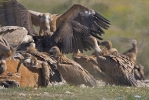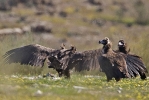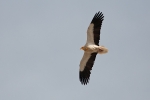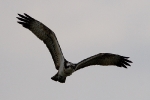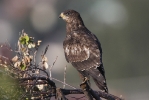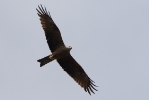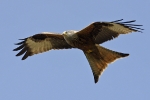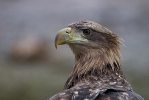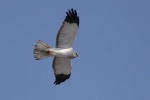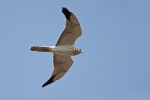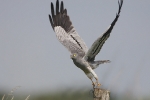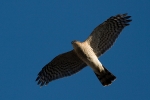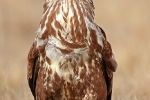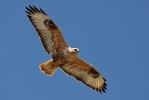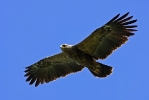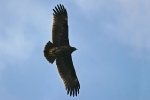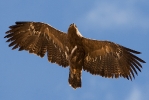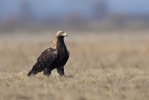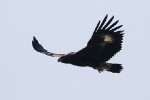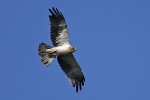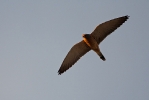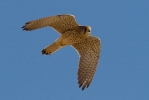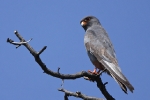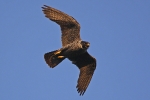2016 IUCN Red List Category: Near Threatened.
Identification. L: 94-125 cm. WS: 231-283cm. Huge vulture with long wings and long, wedge-shaped tail. Adults and immatures differ in coloration and flight silhouette. The adults are greyish-brown above, white or reddish underneath. Wings are long and narrow, almost falcon-like. In contrast the immatures have broad wings with bulging trailing edge. Flies with very deep, flexible wingbeats, glides on flattish wings with arms pressed down and up-bent wing-tips. Voice: sharp whistle while displaying, silent otherwise. Rare breeding species of the high mountains of Southern Europe.
For more information check BirdLife International (2016) Species factsheet: http://www.birdlife.org/datazone/speciesfactsheet.php?id=3370
Estimated European breeding population size and overall trend (BirdLife International, 2012): 610 - 1,000 pairs.
Estimated Hungarian breeding population size: -, there has been no observation within the current borders of Hungary yet.
9 kép
2016 IUCN Red List Category: Least Concern.
Identification. L: 95-110 cm. WS: 230-265cm. Huge, robust vulture with bi-colored upperparts and short, ample tail. Adults and immatures are similar, but the young birds have grey bill, brownish ruff, on the underwing the greater coverts form a wide cream-colored bar and the upper greater coverts are uniform dark. The adults have upper greater coverts with pale edges, the underwing coverts form one or two narrow stripes and the ruff is whitish. Wings are long and broad with bulging trailing edge. Flies with very deep, clumsy wingbeats, glides on flattish wings with arms pressed down and up-bent wing-tips. Soars in a shallow "V". Voice: Hissing and hoarse grunting notes. Breeding species of the high mountains of Southern Europe.
For more information check BirdLife International (2016) Species factsheet: http://www.birdlife.org/datazone/speciesfactsheet.php?id=3378
Estimated European breeding population size and overall trend (BirdLife International, 2015): 32,400 - 34,400 pairs, huge population, increasing trend.
Estimated Hungarian breeding population size: -, rare but more regular recently.
18 kép
2016 IUCN Red List Category: Near Threatened.
Identification. L: 100-115 cm. WS: 250-295cm. Huge, robust vulture (slightly bigger than the Griffon Vulture) with short wedge-shaped or ample tail. Adults and immatures are similar, but the young birds have blackish head and ruff, on the underwing the greater coverts are uniform dark. The adults have somewhat paler greater coverts, the head and the ruff are pale brown. Wings are long and evenly broad. Flies with very deep, clumsy wingbeats, glides and soars on flattish wings with arms pressed down and up-bent wing-tips. Voice: Silent normally. Breeding species of the dry mountains and wooded lowlands of Southern Europe.
For more information check BirdLife International (2016) Species factsheet: http://www.birdlife.org/datazone/species/factsheet/22695231
Estimated European breeding population size and overall trend (BirdLife International, 2004): 1,700 - 1,900 pairs with decreasing trend.
Estimated Hungarian breeding population size: -, rare vagrant.
7 kép
2016 IUCN Red List Category: Endangered.
Identification. L: 54-66 cm. WS: 146-175 cm. Mid-size vulture with long wedge shaped tail and broad, rectangular wings. Adult reminiscent of the White Stork (Ciconia ciconia) with black remiges and white coverts underneath. Similar from above but the center of the remiges are whitish. Immatures are dark-brown with cream-buff coverts and rump. Flies with slow, deep wingbeats, glides on flattish wings with slightly arched arms. Voice: silent. Breeds on rocky mountains in the Mediterranean. Europe holds 25-49% of the world population.
For more information check BirdLife International (2016) Species factsheet: http://www.birdlife.org/datazone/speciesfactsheet.php?id=3371
Estimated European breeding population size and overall trend (BirdLife International, 2016): 3,300 - 5,050 pairs. The species declining in virtually all parts of its range.
Estimated Hungarian breeding population size: -, vagrant.
19 kép
2016 IUCN Red List Category: Least Concern.
Identification. L: 52-60. WS: 152-167 cm. Medium-large, long-winged, with unique flight silhouette. Upperparts uniformly grey-brown. Under-parts pale with dark markings on greater coverts and breast. Crown white. Flight with angled wings, carpals holds forward when gliding. Hovers regularly. Voice: During aerial display whistles mournfully ’u-eelp u-eelp.
The Osprey is a widespread summer visitor to much of northern Europe
(occurring only patchily farther south), which accounts for less than a quarter of its
global breeding range.
For more info check BirdLife International (2016) Species factsheet: http://www.birdlife.org/datazone/species/index.html?action=SpcHTMDetails.asp&sid=3324&m=0
Estimated European breeding population size and overall trend (BirdLife International, 2016): 8,400 - 12,300 pairs, moderate increase between 1990 and 2000.
Estimated Hungarian breeding population size: -, regular autumn and spring migrant.
2 kép
2016 IUCN Red List Category: Least Concern.
Identification. L: 52-59 cm. WS: 113-135 cm. Slightly larger and longer-winged than Common Buzzard. Slim head and long tail. Plumage variable, including dark, medium, pale morphs. Adult: Black trailing edge to wing. Cere dark, eye pale. Juvenile: Flight feathers more densely barred than on adult. Cere yellow, eye dark. Soars on flattish wings. Silent except breeding season. Main call a whistling ’peee-lu’.
The European Honey Buzzard is a widespread summer visitor to Europe, which constitutes >75% of
its global breeding range.
For more info check BirdLife International (2016) Species factsheet: http://www.birdlife.org/datazone/species/index.html?action=SpcHTMDetails.asp&sid=3334&m=0
Estimated European breeding population size and overall trend (BirdLife International, 2016): 118,000-171,000 pairs, stable between 1990 and 2000.
Estimated Hungarian breeding population size (Birds of Prey of Hungary, 2015 in Hungarian): 800 – 1,000 pairs, widespread but not common breeder.
8 kép
2016 IUCN Red List Category: Least Concern.
Identification. L: 48-58 cm. WS: 130-155 cm. Mid-sized, fork-tailed. Darker and smaller than Red Kite, the wing-tip broader and the grey-brown (never rufous) tail less forked. Adult: Upperparts dark-brown with pale mid-wing panel. Juvenile: Similar to adult but with narrow pale tips to upper greater coverts. Buff streaks on breast and belly. Wings held arched and lowered, flight buoyant and leisurely. Voice: A whinnying ’pee-e-e-e, also a buzzard-like mewing call.
The Black Kite is a widespread summer visitor to much of Europe, which accounts for less than a quarter of its global breeding range.
For more info check BirdLife International (2016) Species factsheet: http://www.birdlife.org/datazone/species/index.html?action=SpcHTMDetails.asp&sid=32423&m=0
Estimated European breeding population size and overall trend (BirdLife International, 2016): 81,200 - 109,000 pairs, large decline between 1990 and 2000.
Estimated Hungarian breeding population size (Birds of Prey of Hungary, 2015 in Hungarian): 140 – 160 pairs, breeds in small number.
15 kép
2016 IUCN Red List Category: Near Threatened.
Identification. L: 61-72 cm. WS: 140-165 cm. Medium-large, long-winged, long deeply forked tail. Wings rather narrow and evenly broad. Characteristic yellowish mid-wing band on the upperparts. Adult: Breast and belly deep rufous with narrow dark streaks. Juvenile: Narrow white tips to upper greater coverts. Yellowish streaks on breast and belly. Voice: Rather silent. Buzzard-like mewing followed by drawn-out notes ’we-oh,ee oo ee’.
The Red Kite is endemic to the Western Palearctic, with the European population encompassing 95% of its global breeding range. Despite the current rapid declines in southern Europe, if population increases in northern range states are sustained the species may qualify for downlisting in the future.
For more info check BirdLife International (2016) Species factsheet: http://www.birdlife.org/datazone/species/index.html?action=SpcHTMDetails.asp&sid=3353&m=0
Estimated European breeding population size and overall trend (BirdLife International, 2016): 19,000 – 23,000 pairs, moderate decline between 1990 and 2000.
Estimated Hungarian breeding population size (Birds of Prey of Hungary, 2015 in Hungarian): 4 – 10 pairs, rare breeder.
7 kép
2016 IUCN Red List Category: Least Concern.
Identification. L: 76-92 cm. WS: 190-240cm. Huge, brownish eagle. Long, broad wings, fairly short wedge-shaped tail and long neck. Adult brown with yellowish-brown head and neck. Bill yellow, tail pure white. Juveniles dark-brown, tail longer than that of adults. The trailing edge of the wing bulging, the armpit usually creates white patch. Bill dark. Flies with slow, shallow wingbeats. The wings lowered when gliding and horizontal when soaring. Voice a loud series of shrill 'klee,klee,klee'. The White-tailed Eagle has an extremely large range. Europe forms 50-74% of the global range.
For more information check BirdLife International (2016) Species factsheet: http://www.birdlife.org/datazone/species/index.html?action=SpcHTMDetails.asp&sid=3364&m=0
Estimated European breeding population size and overall trend (BirdLife International, 2016): 9,000 - 12,300 pairs, increasing locally due to conservation.
Estimated Hungarian breeding population size (Birds of Prey of Hungary, 2015 in Hungarian): over 300 pairs, breeds in increasing number.
42 kép
2016 IUCN Red List Category: Least Concern.
Identification. L: 43-55 cm. WS: 115-140 cm. Largest harrier, slim body and long tail. Adult male: Distinctly set-off black wing-tips, uniformly pale blue-grey tail. Head and breast pale-yellowish white. Adult female: Dark brown with creamy-white crown, throat and forewing. Tail brown. Juvenile: Similar to adult female but with more uniform appearance. In flight wings held in a shallow ’V’. Voice: Whining nasal ’way-e’ during display.
The Western Marsh Harrier is a widespread breeder across much of Europe, which accounts for less than half of its global breeding range.
For more info check BirdLife International (2016) Species factsheet: http://www.birdlife.org/datazone/species/index.html?action=SpcHTMDetails.asp&sid=3399&m=0
Estimated European breeding population size and overall trend (BirdLife International, 2016): 99,300 - 184,000 pairs, moderate increase between 1990 and 2000.
Estimated Hungarian breeding population size (Birds of Prey of Hungary, 2015 in Hungarian): 5,200 – 6,700 pairs, common breeder.
29 kép
2016 IUCN Red List Category: Not Recognised.
Identification. L: 45-55 cm. WS: 97-118 cm. Long wings and tail. Somewhat smaller than Marsh Harrier. Adult male: Wing-tips black, underparts white with blue-grey head and breast. Darkish trailing edge to underwing. Adult female: Brown upperparts with white uppertail-coverts. Underparts buffish-white with brownish streaks. Juvenile: like female but more rufous-yellow underneath with fewer streaks. Usually flies low with wings raised in shallow ’V’. Voice: Rapid ’chuck-uk-uk-uk’ given by male during display flight.
The Hen Harrier is a widespread but patchily distributed breeder across much of northern and central Europe, which accounts for less than a quarter of its global breeding range.
For more info check BirdLife International (2016) Species factsheet: http://www.birdlife.org/datazone/species/index.html?action=SpcHTMDetails.asp&sid=3407&m=0
Estimated European breeding population size and overall trend (BirdLife International, 2016): 32,000 - 59, 000 pairs, small decline between 1990 and 2000.
Estimated Hungarian breeding population size: -, common migrant and winter visitor.
14 kép
2016 IUCN Red List Category: Near Threatened.
Identification. L: 40-50 cm. WS: 97-118 cm. Very long and narrow wings and tail. Shape similar to Montague’s Harrier but a bit more compact. Adult male : Very pale, pearl-grey above, white below, wing-tips with narrow black wedges. Adult female: Similar to female Montague’s but uniformly dark-brown secondaries above, pale neck-collar. Juvenile: Similar to juv. Montague’s but prominent buff neck-collar, enhanced by dark brown sides of neck. Flight like that of Montague’s. Voice: Display-call of male high pitched whinnying trill, ’dir-r-r-r’.
The Pallid Harrier is a summer visitor to eastern Europe, which accounts for less than half of its global breeding range. This species is known to be undergoing steep population decline in Europe, although numbers in its Asiatic strongholds are thought to be more stable. Its European breeding population is very small.
For more info check BirdLife International (2016) Species factsheet: http://www.birdlife.org/datazone/species/index.html?action=SpcHTMDetails.asp&sid=3409&m=0
Estimated European breeding population size and overall trend (BirdLife International, 2016): 310 - 1,200 pairs, large decline between 1990 and 2000.
Estimated Hungarian breeding population size: -, regular but rare autumn and spring migrant.
15 kép
2016 IUCN Red List Category: Least Concern.
Identification. L: 39-50 cm. WS: 96-116 cm. Very long and narrow wings and tail. Clearly smaller the Hen Harrier. Adult male: Like Hen Harrier but more black on wing-tips, dark bar across secondaries (two below, one above) Chestnut streaking on belly. Adult female: : Brown upperparts with white uppertail-coverts, underparts buffish-white, streaked brown. Juvenile: Darker than female, uniformly chestnut. Pale tips to greater coverts. Usually flies low with wings raised in shallow ’V’ Voice: Male has a nasal Jackdaw-like ’kyeh, kyeh’ during display flight.
The Montagu’s Harrier has a widespread but patchy breeding distribution in Europe, which constitutes >50% of its global breeding range.
For more info check BirdLife International (2016) Species factsheet: http://www.birdlife.org/datazone/species/index.html?action=SpcHTMDetails.asp&sid=3411&m=0
Estimated European breeding population size and overall trend (BirdLife International, 2016): 54,500 - 92,200 pairs, moderate increase between 1990 and 2000.
Estimated Hungarian breeding population size (Birds of Prey of Hungary, 2015 in Hungarian): 60 - 150 pairs, regular but decreasing breeder.
46 kép
2016 IUCN Red List Category: Least Concern.
Identification. L: male 29-34, female 35-41 cm. WS: male 58-65, female 67-80 cm. Small, with rather short, broad, blunt-tipped wings and long tail. Marked sexual difference. Adul: bluish upperparts, whitish below, barred grey. Male has rufous cheek and belly. Female larger than male, barring below is brown-grey. Juvenile: Dark brown-upperparts, barring on underparts often coarse, irregular on breast. Flight characteristic , few quick wing beats followed by a short glide. Voice: Main call rapid ’kewkewkewkew’.
The Eurasian Sparrowhawk is a widespread breeder across most of Europe, which accounts for less than half of its global breeding range.
For more info check BirdLife International (2016) Species factsheet: http://www.birdlife.org/datazone/species/index.html?action=SpcHTMDetails.asp&sid=3455&m=0
Estimated European breeding population size and overall trend (BirdLife International, 2016): 403,000 - 582,000 pairs, small increase between 1990 and 2000.
Estimated Hungarian breeding population size (Birds of Prey of Hungary, 2015 in Hungarian): 1,000 – 2,000 pairs, fairly common breeder.
10 kép
2016 IUCN Red List Category: Least Concern.
Identification. L: male 49-56, female 58-64 cm. WS: male 93-105, female 108-120 cm. Medium-large, strong, broad-winged and long-tailed. Marked sexual difference. Adult: bluish upperparts, whitish below, barred grey. Male has stronger dark facial pattern. Juvenile: Brown above; buff-white below, coarsely streaked brown. Active flight with slow wing beats followed by short glides. Soars on flat wings. Voice: Silent outside breeding season. Call a loud ’kya-kya-kya-kya’.
The Northern Goshawk is a widespread resident across most of Europe, which accounts for less than half of its global range.
For more info check BirdLife International (2016) Species factsheet: http://www.birdlife.org/datazone/species/index.html?action=SpcHTMDetails.asp&sid=3466&m=0
Estimated European breeding population size and overall trend (BirdLife International, 2016): 166,000 – 220,000 pairs, moderate increase between 1990 and 2000.
Estimated Hungarian breeding population size (Birds of Prey of Hungary, 2015 in Hungarian): 1,500 – 2,000 pairs, fairly common breeder.
9 kép
2016 IUCN Red List Category: Not Recognised.
Identification. L: 46-58 cm. WS: 110-132 cm. Mid-sized, broad-winged, compact with medium-length tail. Adult generally brown on the upperside, usually has pale breast band. Dark trailing edge to wing. Juvenile: No distinctly broader tail-band. Underparts coarsely streaked. Eye paler than adult. Flies with rather quick wing beats, soars with wings held in a ’V’. Hovers frequently. Voice: Highly vocal. Mewing ’piiiyay’.
The Common Buzzard is a widespread breeder across most of Europe, which accounts for less than half of its global breeding range.
For more info check BirdLife International (2016) Species factsheet: http://www.birdlife.org/datazone/species/index.html?action=SpcHTMDetails.asp&sid=32591&m=0
Estimated European breeding population size and overall trend (BirdLife International, 2016): 710,000 – 1,200,000 pairs, small increase between 1990 and 2000.
Estimated Hungarian breeding population size (Birds of Prey of Hungary, 2015 in Hungarian): 15,000 – 20,000 pairs, very common breeder.
61 kép
2016 IUCN Red List Category: Not Recognised.
Identification. L: 50-61 cm. WS: 130-150 cm. Large and long-winged buzzard, almost eagle-like. Silhouette as for Rough-legged Buzzard. Adult: Tail unbarred pale rufous above, paler below. Broad black trailing edge to wing. Juvenile: Tail greyish-buff, finely barred grey, indistinct dark band along trailing edge. Flight as for Rough-legged Buzzard. Voice: Rather silent, similar to Rough-legged Buzzard.
The Long-legged Buzzard is a widespread breeder in south-eastern Europe, which accounts for less than a quarter of its global breeding range.
For more info check BirdLife International (2016) Species factsheet: http://www.birdlife.org/datazone/species/index.html?action=SpcHTMDetails.asp&sid=32592&m=0
Estimated European breeding population size and overall trend (BirdLife International, 2004): 8,700 – 15,000 pairs, large decline between 1990 and 2000.
Estimated Hungarian breeding population size (Birds of Prey of Hungary, 2015 in Hungarian): 4 – 10 pairs, regular but rare breeder. Interbreeding with B. buteo: 2 -4 pairs.
21 kép
2016 IUCN Red List Category: Least Concern.
Identification. L: 55-65 cm. WS: 143-168 cm. Mid-sized, generally brown and compact eagle. Adult brown with pale-yellowish head/neck and upperwing coverts. Juvenile darker brown with white-tipped greater coverts, trailing edge and tail. Flies with quick wing beats and angled and lowered wings. Voice: Very vocal in breeding area. High-pitched ’k-yeep’ and whistle ’wiik’ during aerial display.
The Lesser Spotted Eagle is a summer visitor to east-central Europe, which constitutes more than 73% of its global breeding range.
For more info check BirdLife International (2016) Species factsheet: http://www.birdlife.org/datazone/species/index.html?action=SpcHTMDetails.asp&sid=3530&m=0
Estimated European breeding population size and overall trend (BirdLife International, 2016): 16,400 - 22,100 pairs, moderate decline between 1990 and 2000.
Estimated Hungarian breeding population size (Birds of Prey of Hungary, 2015 in Hungarian): 35 – 45 pairs, breeds in small number.
33 kép
2016 IUCN Red List Category: Vulnerable.
Identification. L: 59-69 cm. WS: 153-177 cm. Largish, dark, compact eagle. Adult dark brown with slightly paler head. Juvenile purplish brown-black with white spots on upperwing coverts and tail. Flight more laboured than that of Lesser Spotted Eagle. Voice: Similar to Lesser Spotted Eagle but lower pitched.
The Greater Spotted Eagle has a small population which appears to be declining owing to extensive habitat loss and persistent persecution. It is a summer visitor to north-eastern Europe, which accounts for less than half of its global breeding range.
For more info check BirdLife International (2016) Species factsheet: http://www.birdlife.org/datazone/species/index.html?action=SpcHTMDetails.asp&sid=3531&m=0
Estimated European breeding population size and overall trend (BirdLife International, 2016): 810 – 1,100 pairs, large decline between 1990 and 2000.
Estimated Hungarian breeding population size: -, regular but rare autumn and spring migrant.
5 kép
2016 IUCN Red List Category: Endangered.
Identification. L: 62-74 cm. WS: 165-190 cm. Large brown eagle. Adult mid-brown with long and broad wings. Grey base to tail, pale uppertail coverts. Juvenile brown with broad pale wing band along centre of underwing. Holds wings flat with drooping hands. Voice: Rather silent. Usually low barking.
The Steppe Eagle has a predominantly Asian distribution, which just extends into easternmost Europe.
For more info check BirdLife International (2016) Species factsheet: http://www.birdlife.org/datazone/species/index.html?action=SpcHTMDetails.asp&sid=3533&m=0
Estimated European breeding population size and overall trend (BirdLife International, 2016): 800 – 1,200 pairs, large decline between 1990 and 2000.
Estimated Hungarian breeding population size: -, rare summer vagrant as well as autumn and spring migrant.
21 kép
2016 IUCN Red List Category: Vulnerable.
Identification. L: 75-84 cm. WS: 175-205cm. Large, dark eagle. Adult generally dark brown with white scapular markings and pale golden-cream nape. Grey base to tail. Juvenile brown fading to pale buff with dark flight feathers. Shows flat wings in flight. Holds wings in flattened "V" shape. Voice Repeated barking.
The Eastern Imperial Eagle has a small global population, and is likely to be undergoing continuing declines, primarily as a result of habitat loss and degradation, adult mortality through persecution and collision with power lines, nest robbing and prey depletion.
For more info check BirdLife International (2016) Species factsheet: http://www.birdlife.org/datazone/species/index.html?action=SpcHTMDetails.asp&sid=3535&m=0
Estimated European breeding population size and overall trend (BirdLife International, 2015): 1,800-2,200 pairs, stable.
Estimated Hungarian breeding population size (Birds of Prey of Hungary, 2015 in Hungarian): 155 – 170 pairs, breeds in increasing number.
105 kép
2016 IUCN Red List Category: Least Concern.
Identification. L: 80-93 cm. WS: 190-225 cm. Large, darkish eagle with long wings and tail. Adult rather dark-brown with yellowish shawl. Grey base to tail. Juvenile chocolate brown with striking white primary/secondary patches. Holds wings in an obvious shallow ’V’. Voice: Rather silent. A repeated fluty whistle.
The Golden Eagle has a widespread but discontinuous distribution across much of Europe, which accounts for less than a quarter of its global breeding range.
For more info check BirdLife International (2016) Species factsheet: http://www.birdlife.org/datazone/speciesfactsheet.php?id=3537
Estimated European breeding population size and overall trend (BirdLife International, 2016): 9,300-12,300 pairs, stable between 1990 and 2000.
Estimated Hungarian breeding population size (Birds of Prey of Hungary, 2015 in Hungarian): 4 - 6 pairs, rare breeder.
13 kép
2016 IUCN Red List Category: Least Concern.
Identification. L: 42-51. WS: 110-135 cm. Smallish eagle, size and shape similar to a buzzard. Adult and juvenile are similar. Tail square-cut, wing has 6 fingers, broader than buzzard. Two morphs: pale has white underbody and white underwing coverts contrasting against black flight-feathers. Dark morph has dark-brown underbody and underwing-coverts. Most show characteristic white patch on the leading edge of the wing. Upperparts on both morphs have pale buff panel across inner upperwing, whitish uppertail coverts. Flight is more eagle-like with faster speed and longer glides. Voice: Vocal in breeding season. Main call shrill ’kli kli kli’.
The Booted Eagle is a widespread summer visitor to much of south-west and eastern Europe, which accounts for less than half of its global breeding range.
For more info check BirdLife International (2016) Species factsheet: http://www.birdlife.org/datazone/species/index.html?action=SpcHTMDetails.asp&sid=3543&m=0
Estimated European breeding population size and overall trend (BirdLife International, 2016): 23,100 - 29,100 pairs, stable between 1990 and 2000.
Estimated Hungarian breeding population size (Birds of Prey of Hungary, 2015 in Hungarian): 0 - 2 pairs, rare and irregular breeder.
3 kép
2016 IUCN Red List Category: Least Concern
Identification. L: 27-33. WS: 63-72 cm. Small, elegant falcon. Adult male: Similar to Kestrel but lacks black spots on upperparts and has a narrow bluish wing panel formed by the greater coverts. Underwing more whitish with blacker wingtip. Adult female/Juvenile: Similar to Kestrel often inseparable. On average paler underwing and underbody. Flight is very similar to Kestrel but wings and tail slightly shorter. Voice: Diagnostic contact-call trisyllabic, high-pitched ’chay-chay-chay’.
The Lesser Kestrel is a summer visitor to southern Europe, which accounts for less than half of its global breeding range.
For more info check BirdLife International (2016) Species factsheet: http://www.birdlife.org/datazone/species/index.html?action=SpcHTMDetails.asp&sid=3589&m=0
Estimated European breeding population size and overall trend (BirdLife International, 2016): 25,000-42,000 pairs, small decline between 1990 and 2000.
Estimated Hungarian breeding population size: -, vagrant.
13 kép
2016 IUCN Red List Category: Least Concern.
Identification. L: 31-37. WS: 68-78 cm. Mid-sized falcon with long wings and tail. Adult male: Rump and uppertail unbarred blue-grey, tail with wide, black band. Back and upperwing-coverts deep chestnut with small black spots. Adult female: Rump and uppertail brown, finely barred. Upperparts warm brown, less reddish than male. Tail always barred. Hovers frequently, wing beats looser than other falcons. Voice: Main call a fast series of sharp notes, ’kee-kee-kee-kee’.
The Common Kestrel is a widespread breeder across most of Europe, which accounts for less than a quarter of its global breeding range.
For more info check BirdLife International (2016) Species factsheet: http://www.birdlife.org/datazone/species/index.html?action=SpcHTMDetails.asp&sid=3590&m=0
Estimated European breeding population size and overall trend (BirdLife International, 2016): 409,000 - 603,000 pairs, moderate decline between 1990 and 2000.
Estimated Hungarian breeding population size (Birds of Prey of Hungary, 2015 in Hungarian): 6,200 – 7,400 pairs, fairly common breeder.
26 kép
2016 IUCN Red List Category: Near Threatened.
Identification. L: 28-34. WS: 65-76 cm. Mid-sized falcon with long wings and tail. Adult male: Unique combination of dark blue-grey body, dull red ’trousers’ and undertail and pale silvery-grey flight feathers. Adult female: Virtually pale rufous-buff underbody, back slate-grey barred dark. Juvenile: Underparts rich-buff, streaked dark. Short, dark mustachial stripe and mask through eye. Underwing has prominent dark trailing edge. Kestrel-like flight with rather loose wing beats, while catching insect in-flight resembles Hobby. Voice: Flight-call a whining ’kew-kew-kew’.
The Red-footed Falcon is a widespread summer visitor to much of Eastern Europe, which accounts for less than half of its global breeding range.
For more info check BirdLife International (2016) Species factsheet: http://www.birdlife.org/datazone/species/index.html?action=SpcHTMDetails.asp&sid=3603&m=0
Estimated European breeding population size and overall trend (BirdLife International, 2016): 26,000 - 39,000 pairs, large decline between 1990 and 2000.
Estimated Hungarian breeding population size (Birds of Prey of Hungary, 2015 in Hungarian): estimated 1,250 - 1,350 pairs.
16 kép
2016 IUCN Red List Category: Endangered.
Identification: L: 47-55. WS: 105-129 cm. Large falcon with broad wings with blunt tip and long tail. Adult: Head usually rather pale brown with whitish supercilium, crown finely streaked, mustachial stripe narrow. Upperparts tawny-brown, underparts prominently streaked from lower throat down. Dark trousers and boldly streaked flanks. Dark-brown underwing coverts contrast with grey flight feathers. Juvenile: Similar to adult but somewhat darker. Flight is similar to Peregrine, but owing to longer wings more stable with slower and more elastic wing beats. Prey often taken on ground. Voice: Rather similar to Peregrine, though slower and more whining (Svensson&Grant, 1999).
The Saker breeds mainly in Central and SE Europe, which holds only a small proportion (c. 7%) of its global breeding population.
For more info check BirdLife International (2016) Species factsheet: http://www.birdlife.org/datazone/species/factsheet/22696495
Estimated European breeding population size and overall trend (CMS Raptors MoU, 2013): 637 – 823 pairs
Estimated Hungarian breeding population size (Birds of Prey of Hungary, 2015 in Hungarian): 160 – 230 pairs, breeds in small number.
40 kép
2016 IUCN Red List Category: Not Recognised.
Identification. L: male 38-45, female 46-51. WS: male 89-100, female 104-113 cm. Mid-sized to large; strong sexual size difference. Adult: Slate-grey above, lower back pale blue-grey. Underparts white, lower breast, belly finely barred. Black hood and distinct mustachial stripe. Juvenile: best recognized by streaked belly and breast. Upperparts are brownish. In flight fairly quick, rather shallow wing beats, speed moderate, when prey spotted speed accelerates suddenly. Voice: Main call harsh cackling ’rehk-rehk-rehk’.
The Peregrine Falcon is a widespread but patchily distributed breeder across much of Europe, which accounts for less than a quarter of its global range.
For more info check BirdLife International (2016) Species factsheet: http://www.birdlife.org/datazone/species/index.html?action=SpcHTMDetails.asp&sid=3622&m=0
Estimated European breeding population size and overall trend (BirdLife International, 2004): 12,000 – 25,000 pairs, moderate increase between 1990 and 2000.
Estimated Hungarian breeding population size (Birds of Prey of Hungary, 2015 in Hungarian): 50 - 70 pairs, rare breeder.
14 kép


